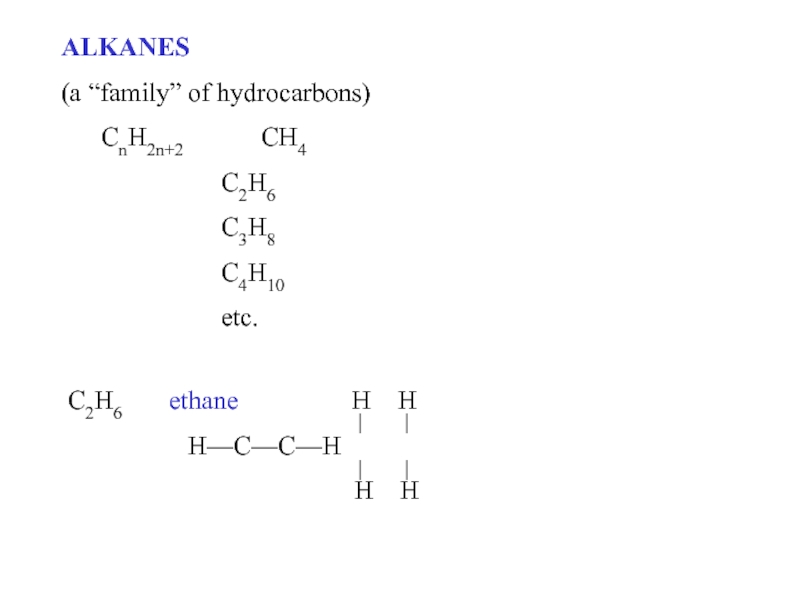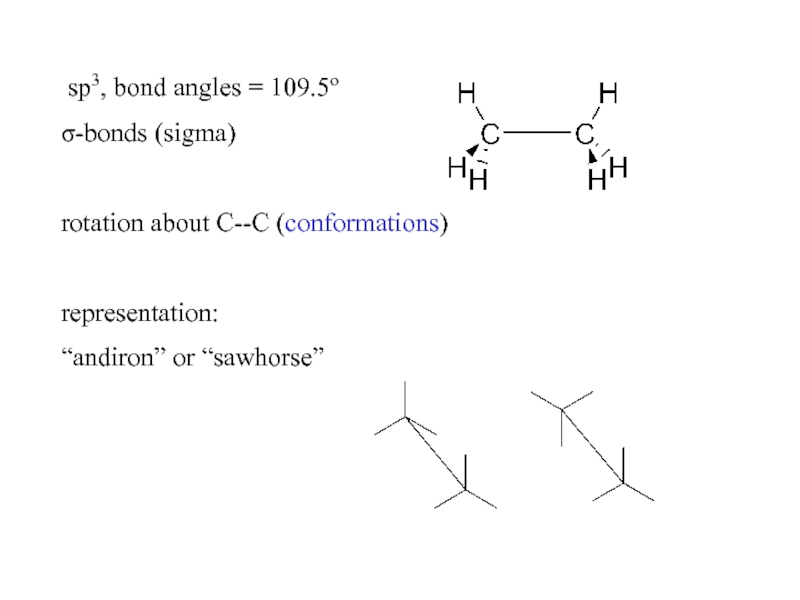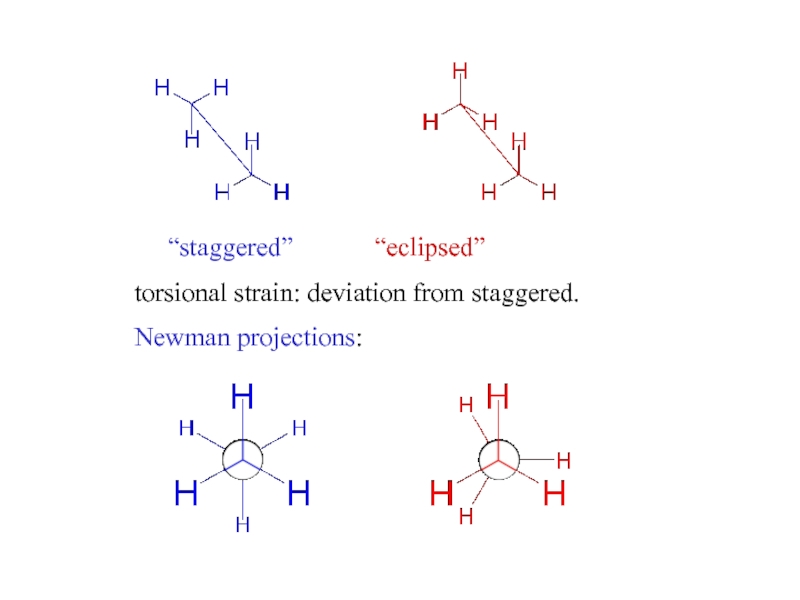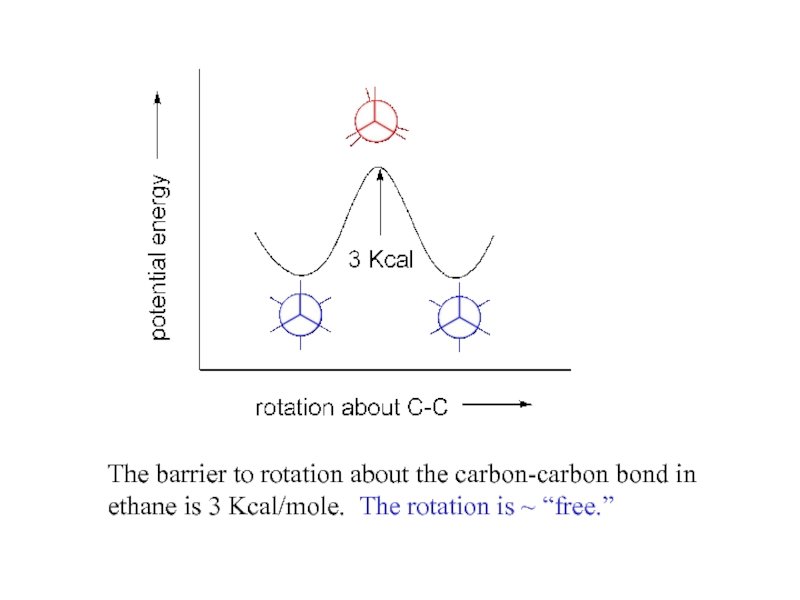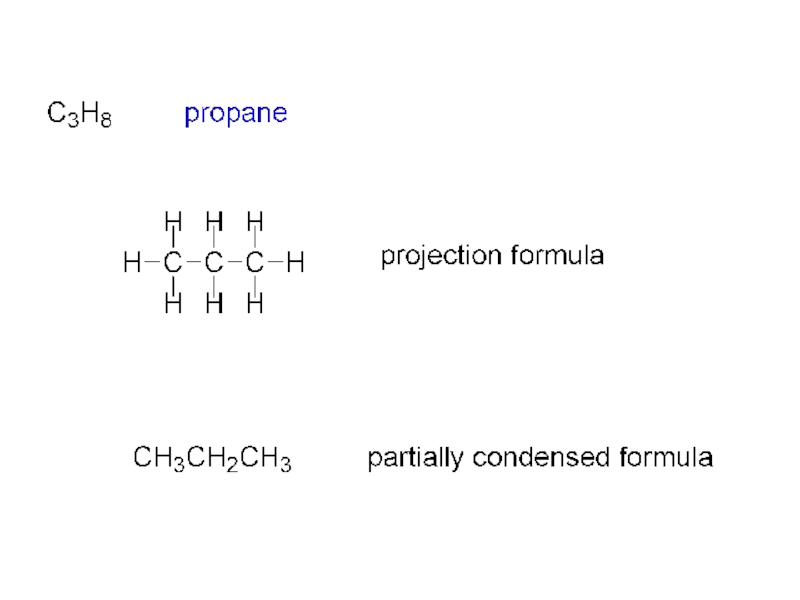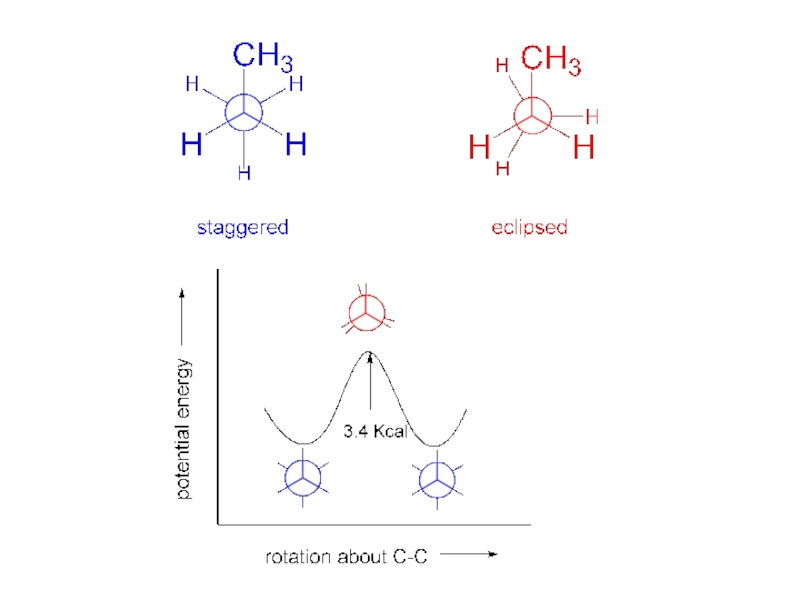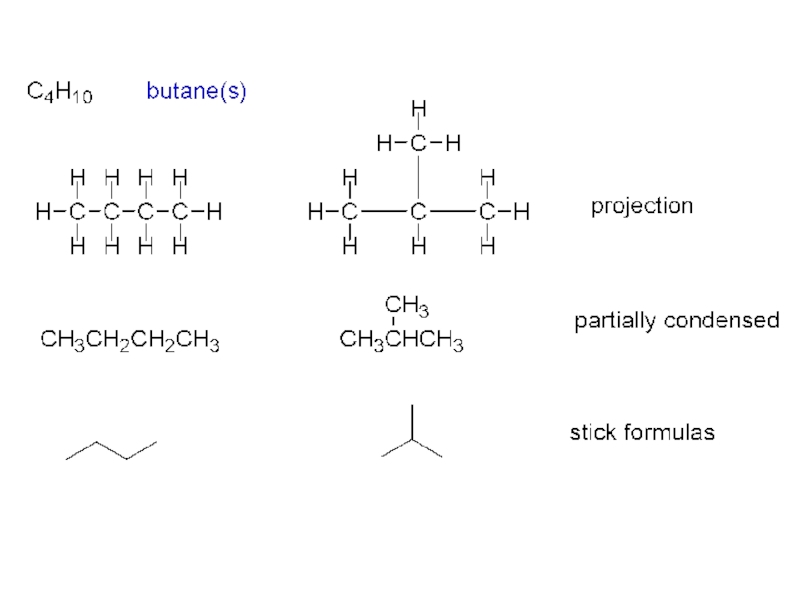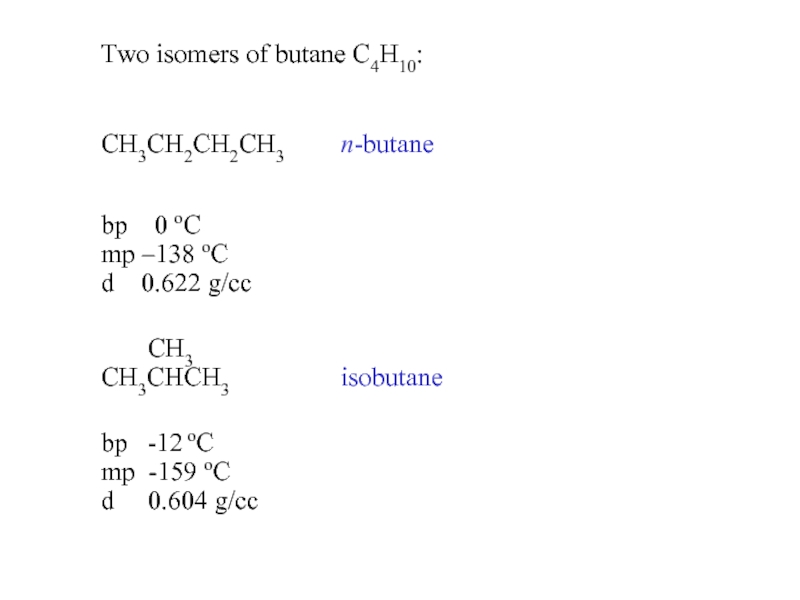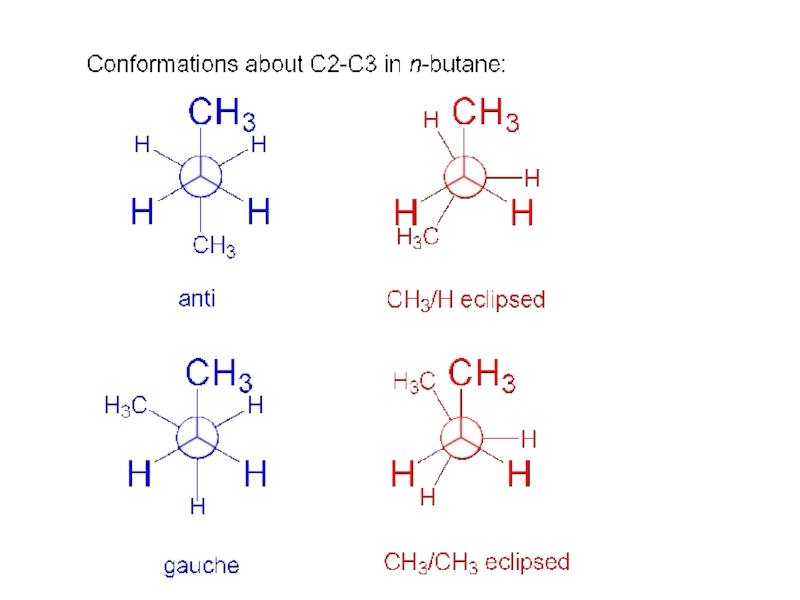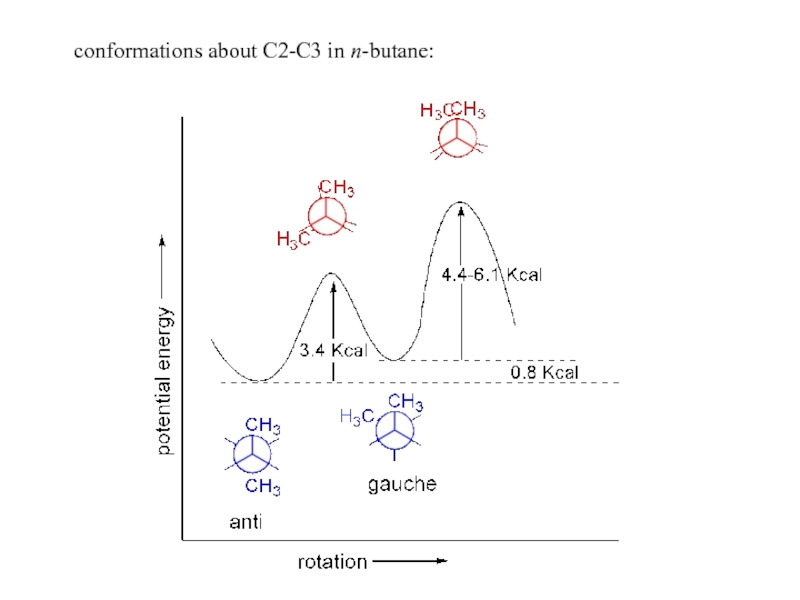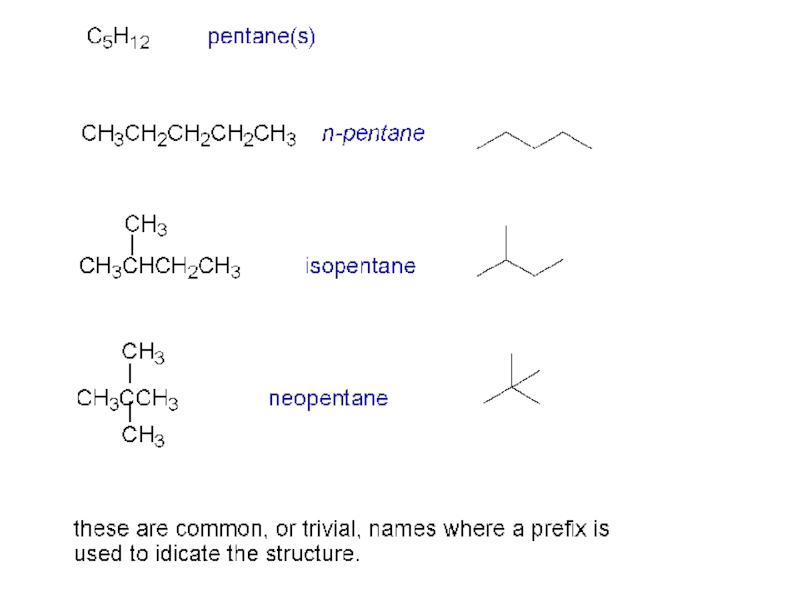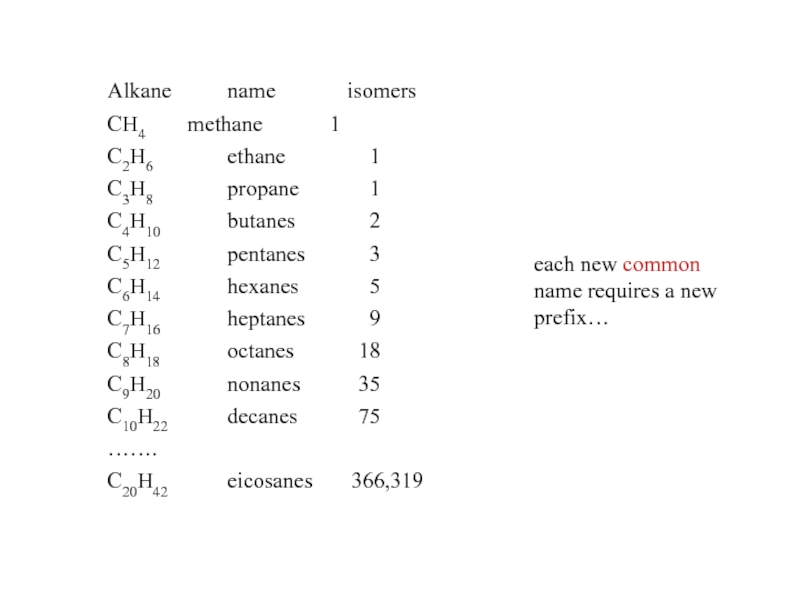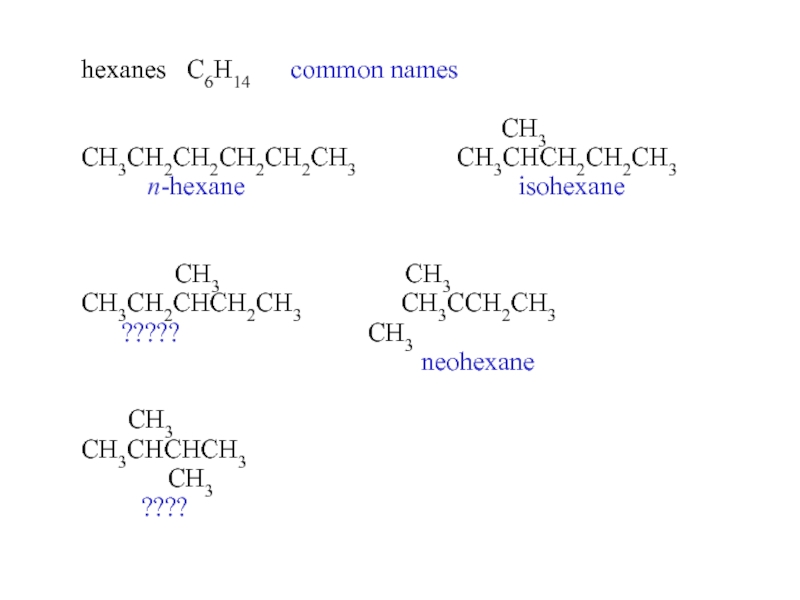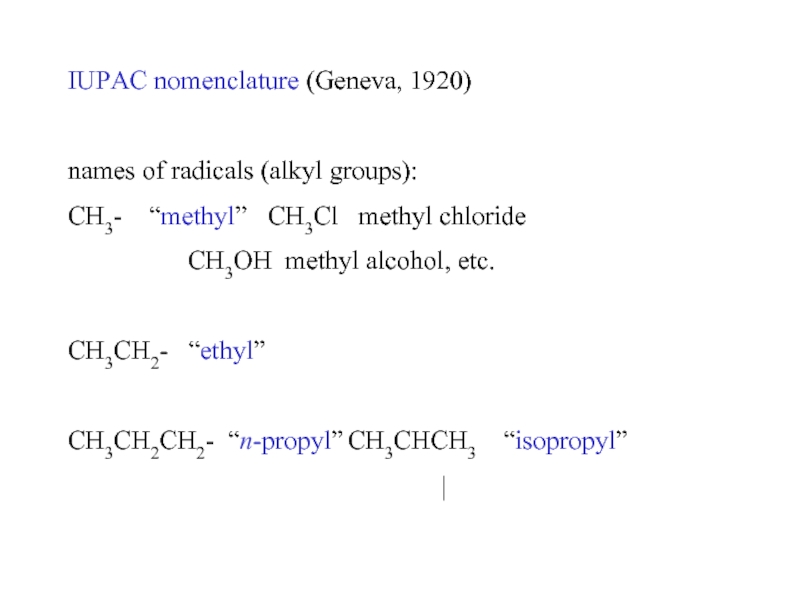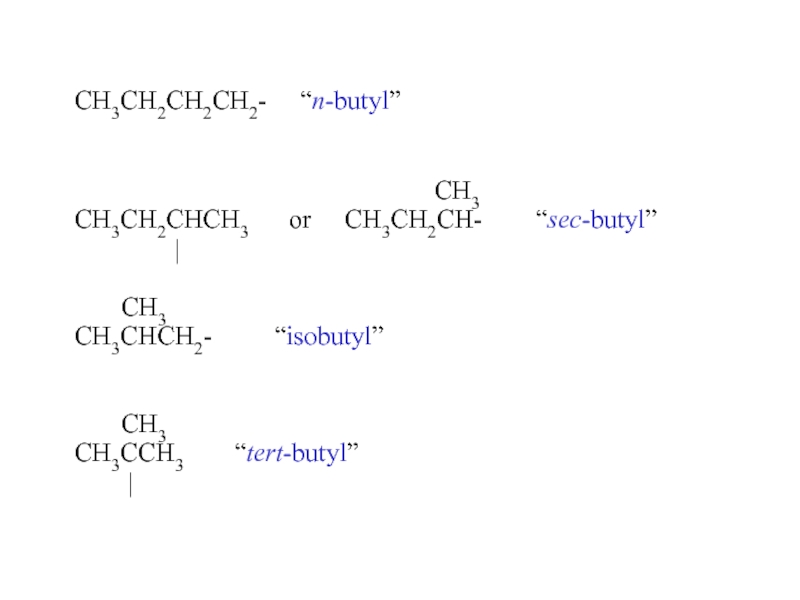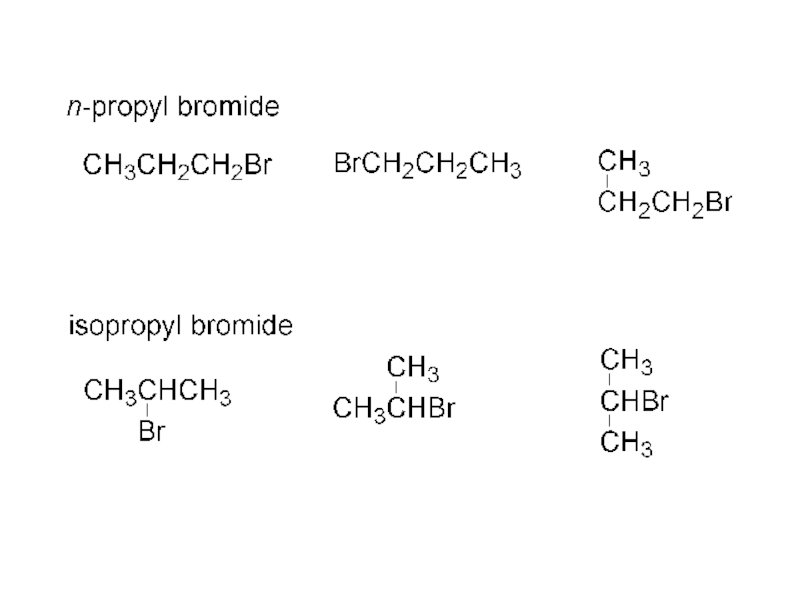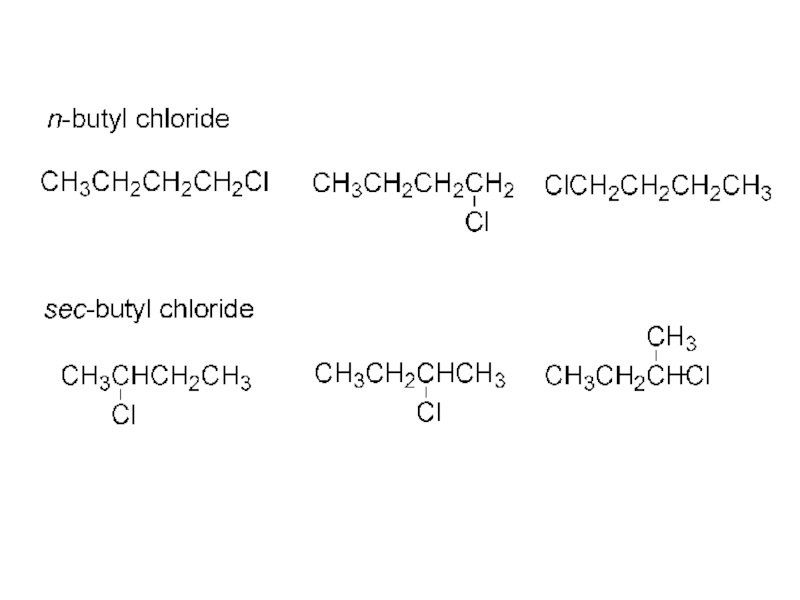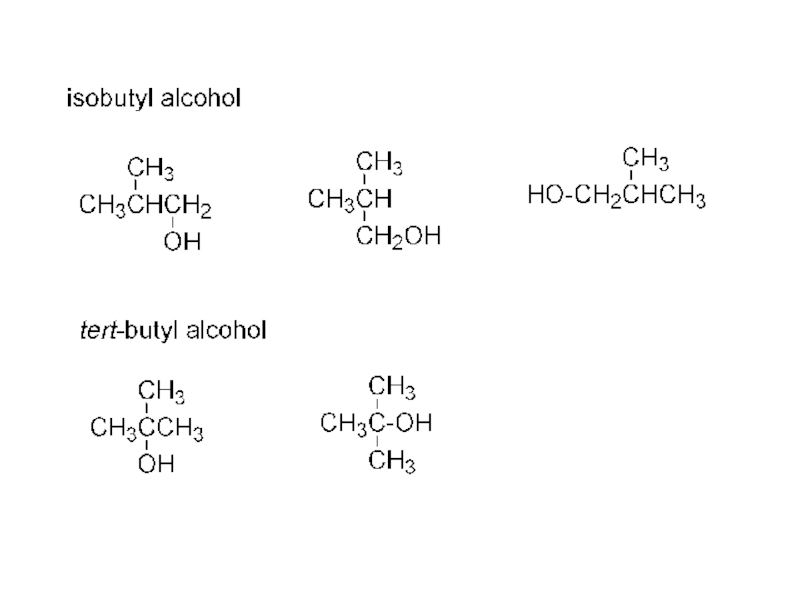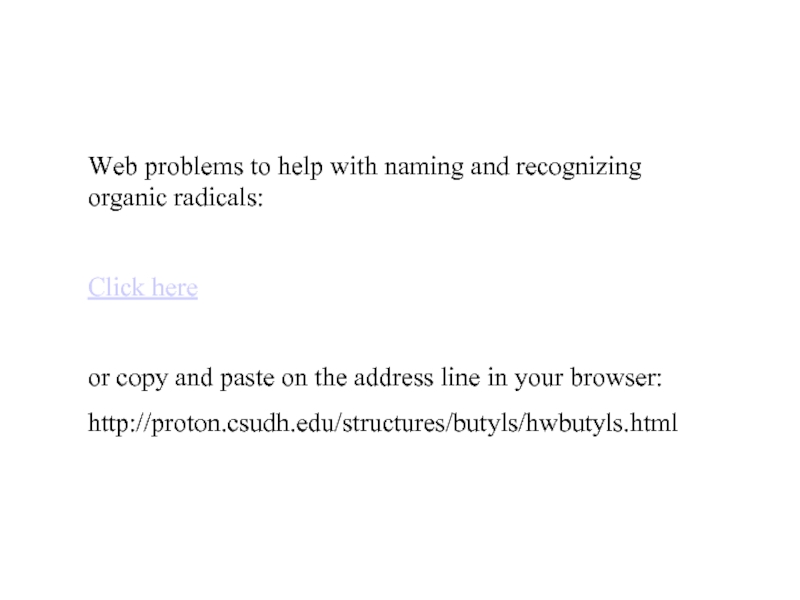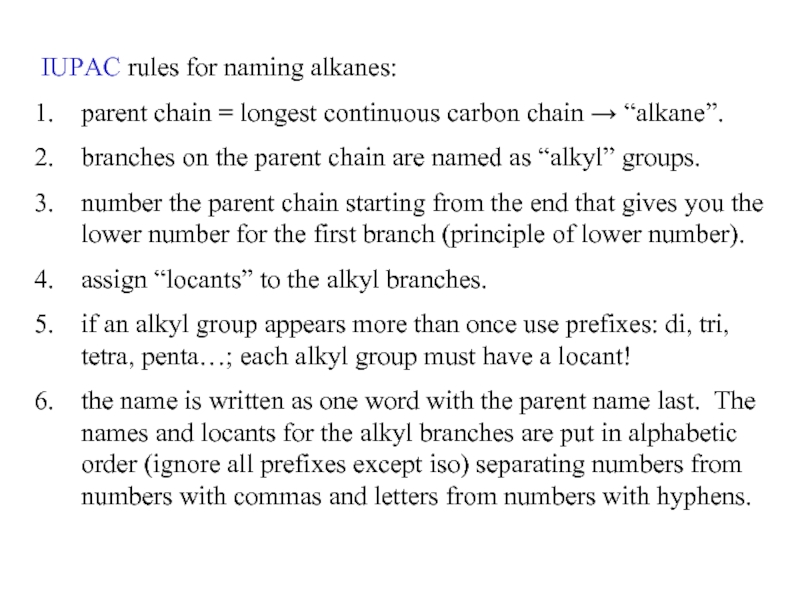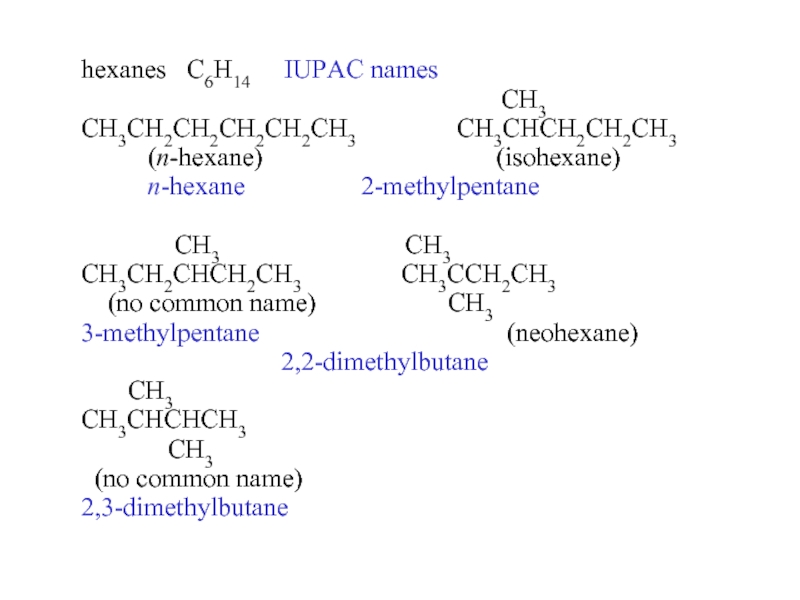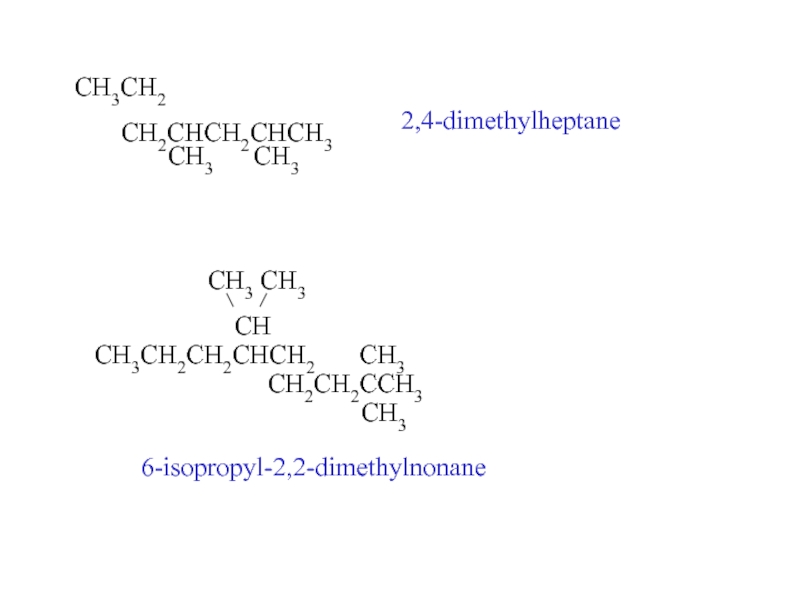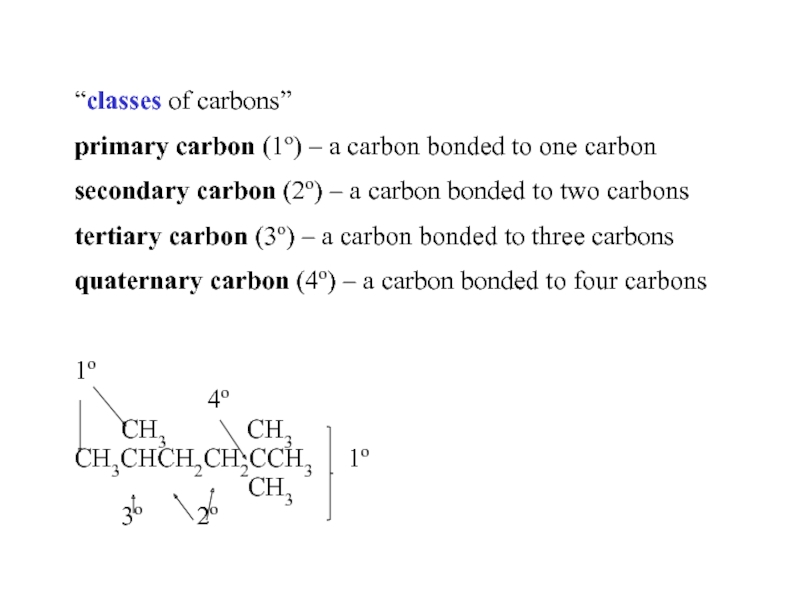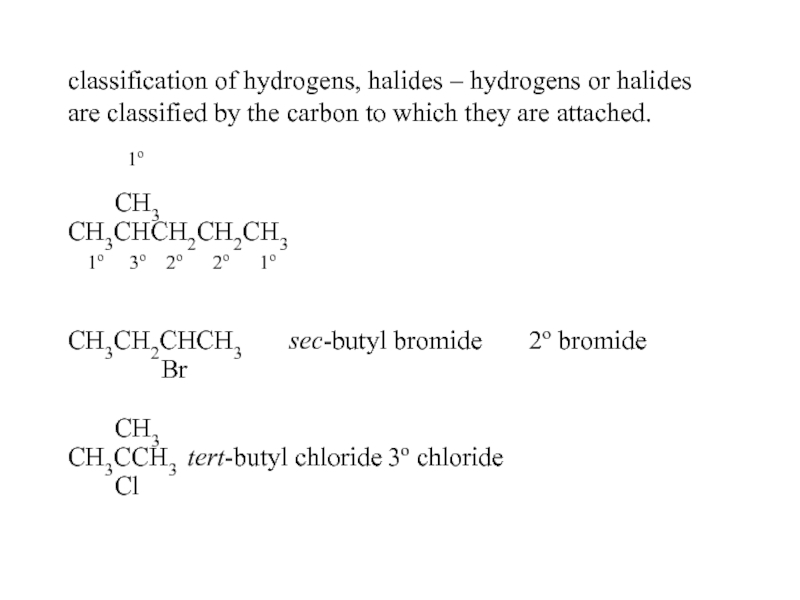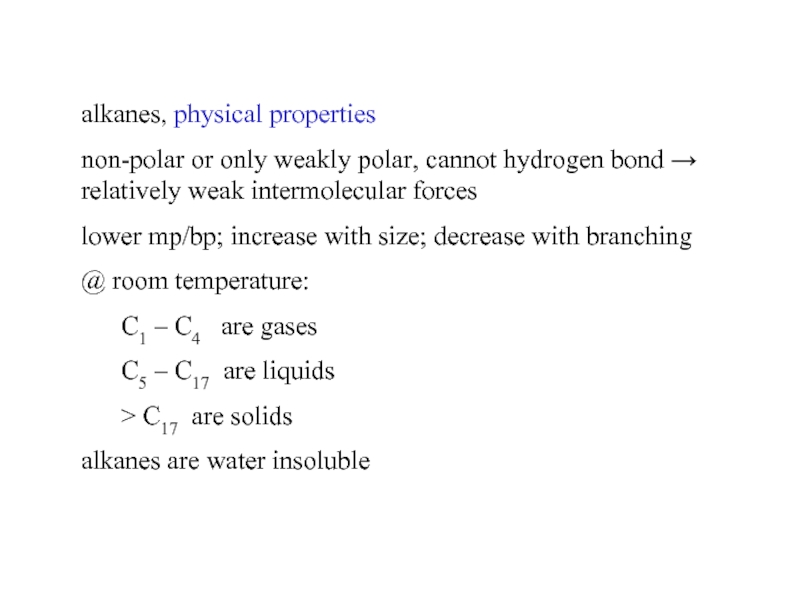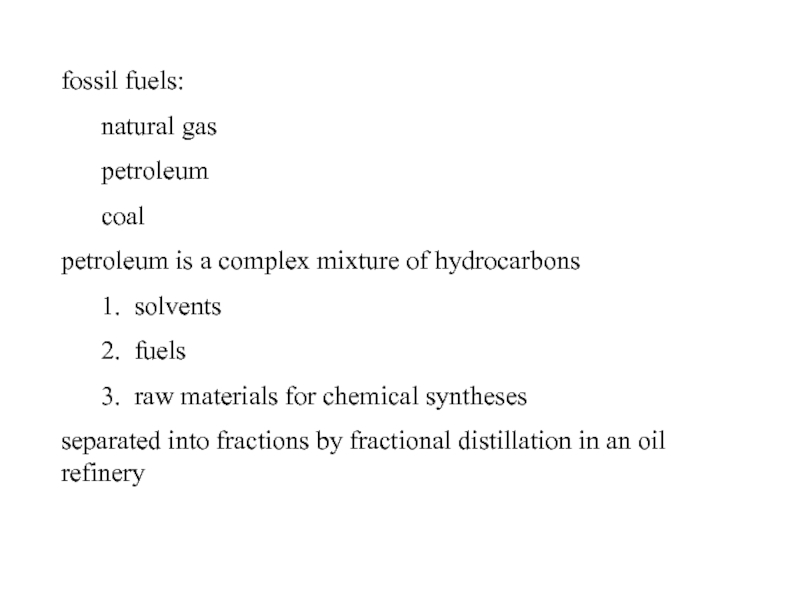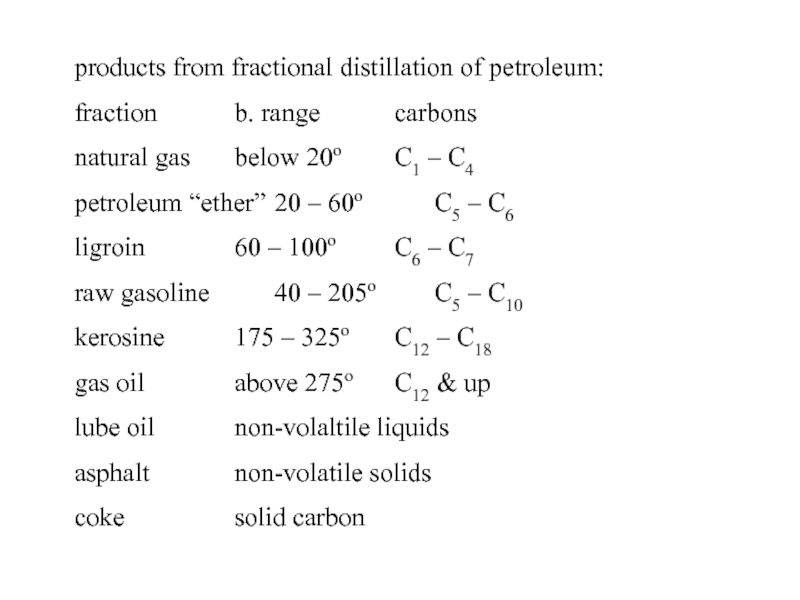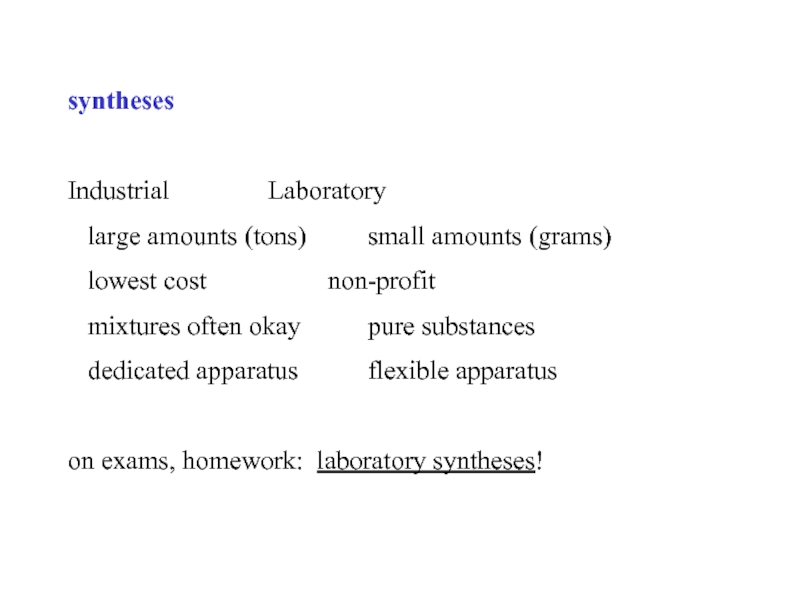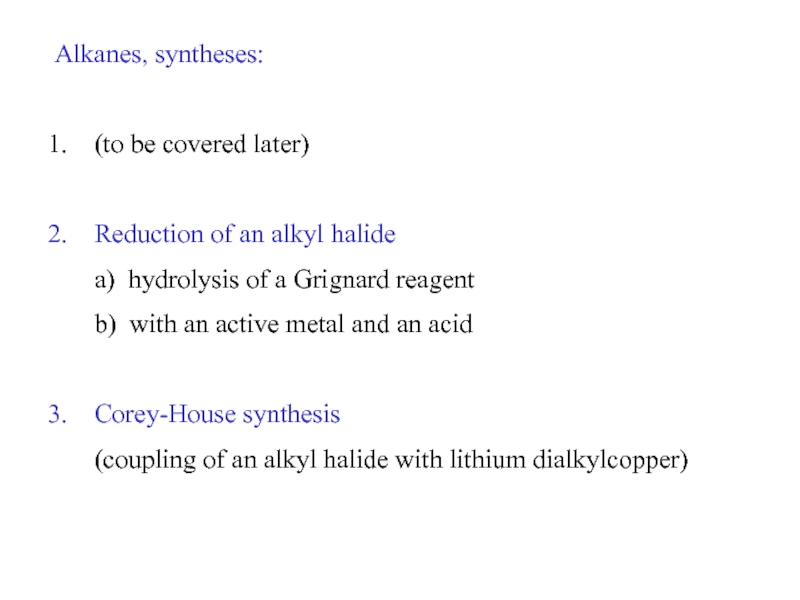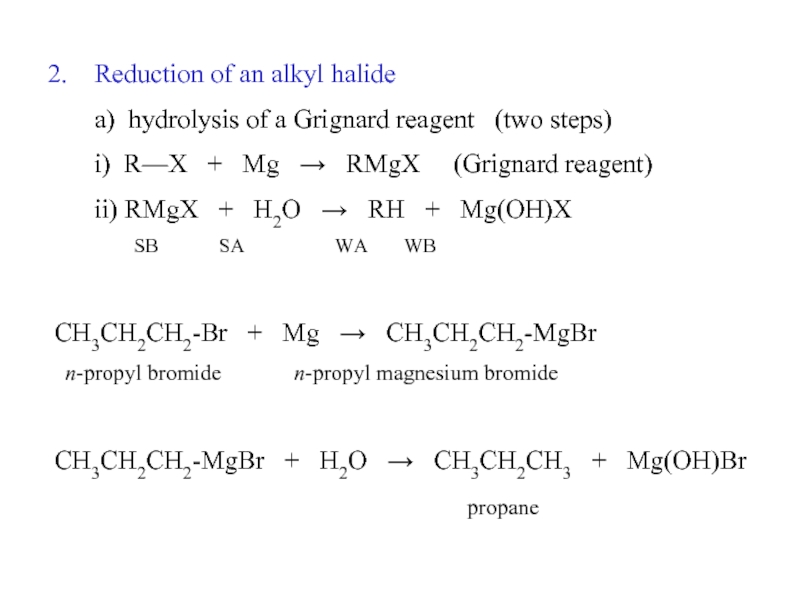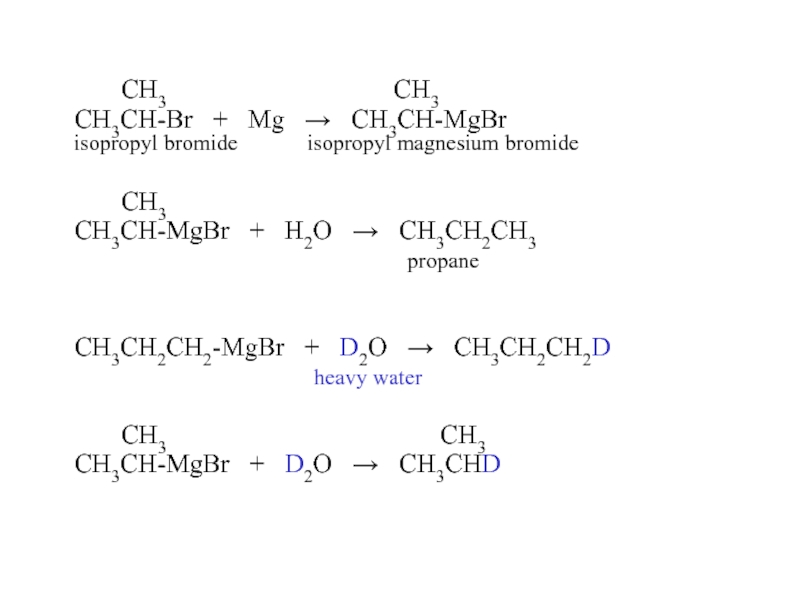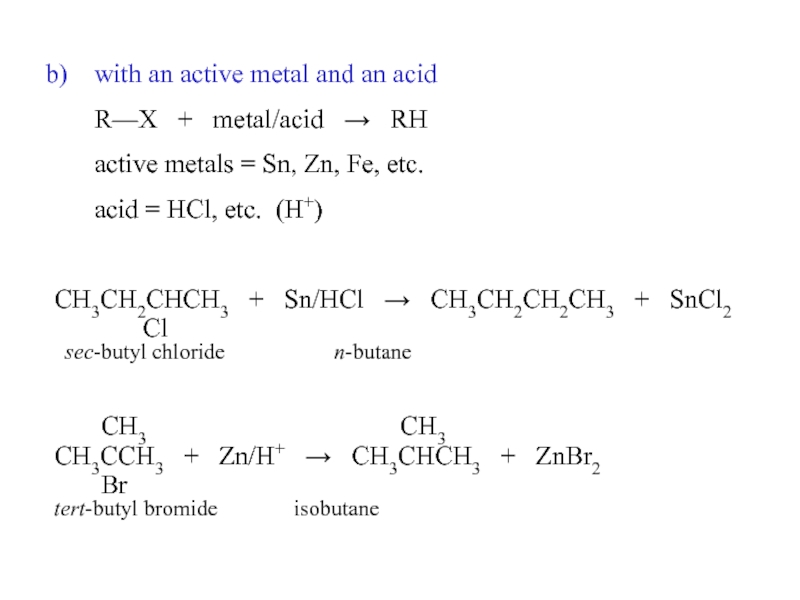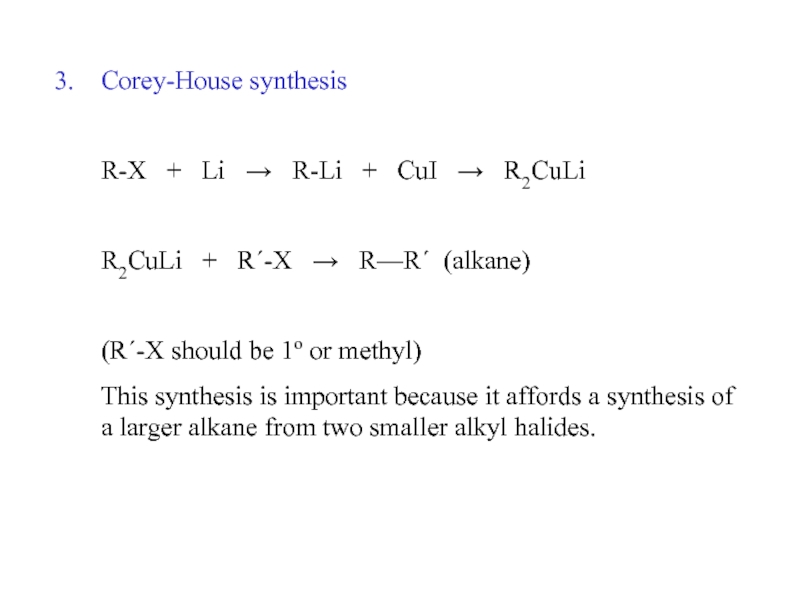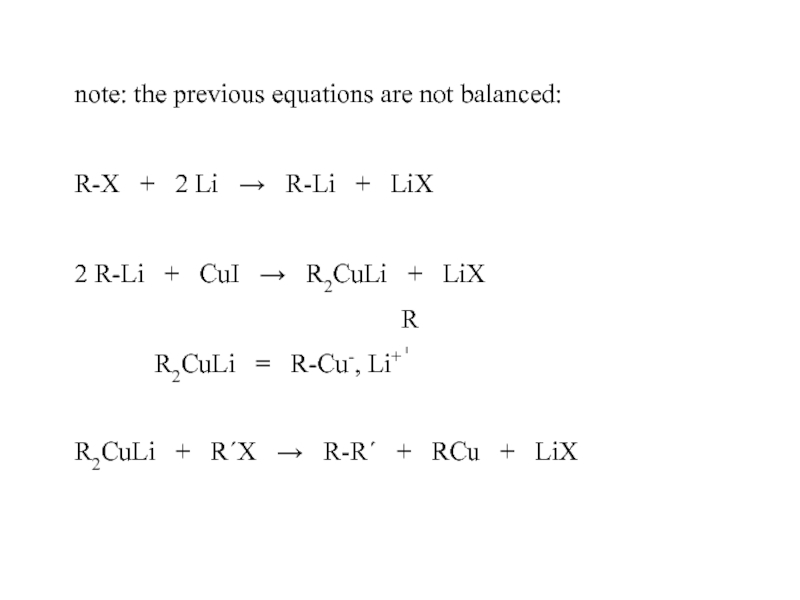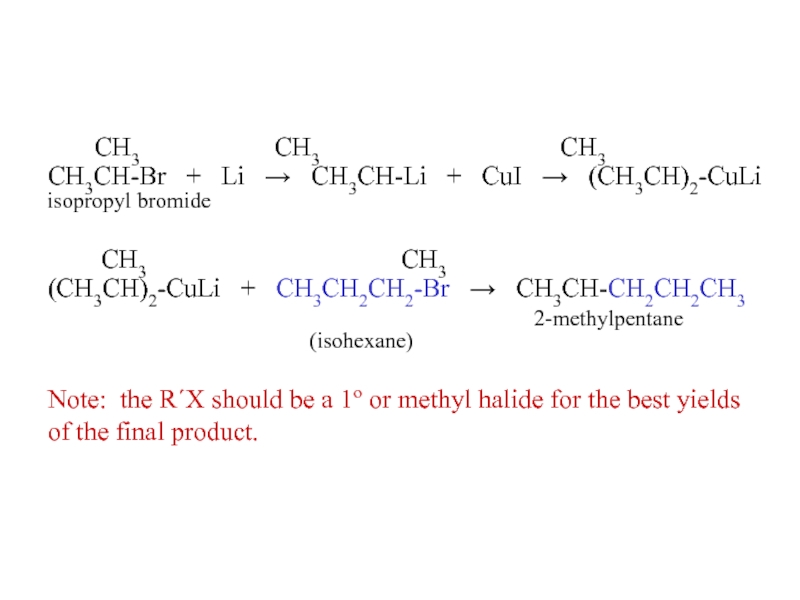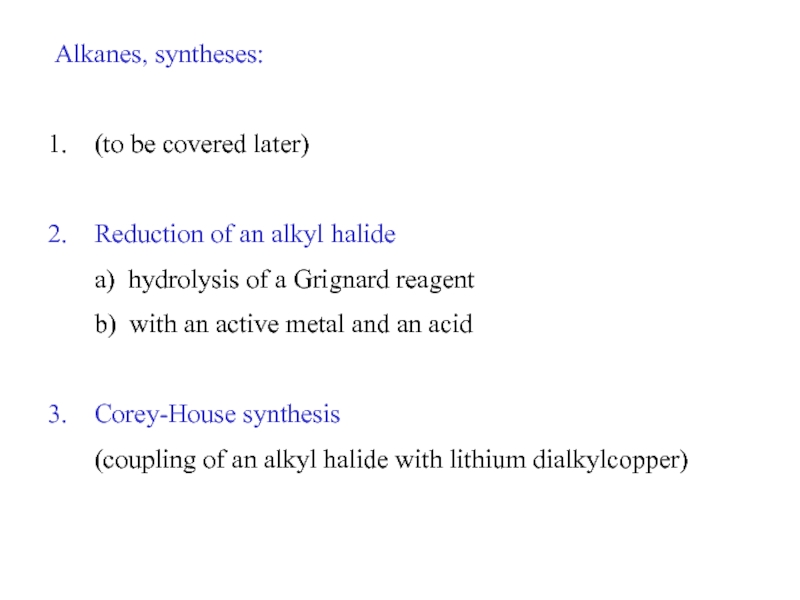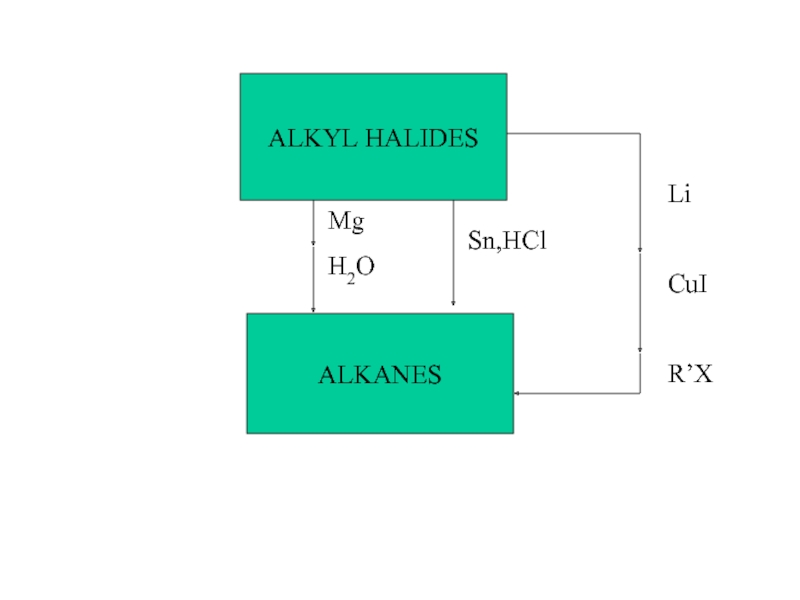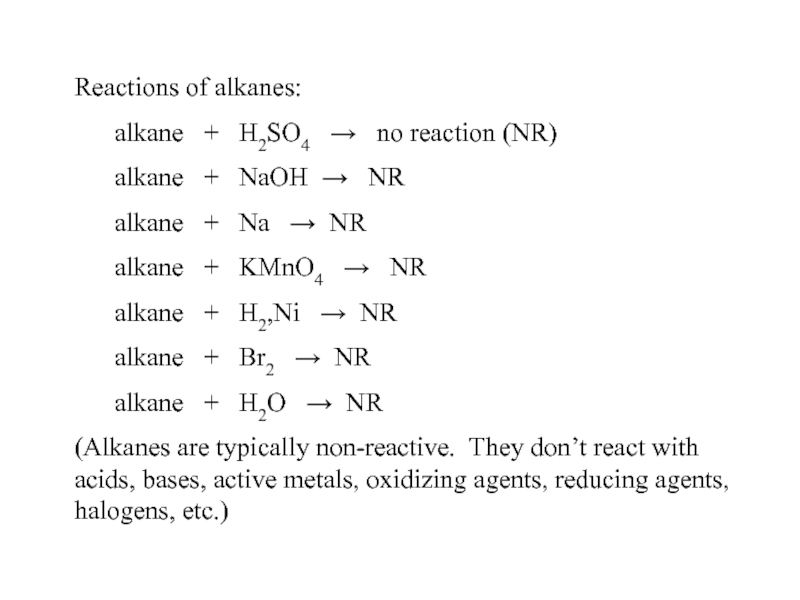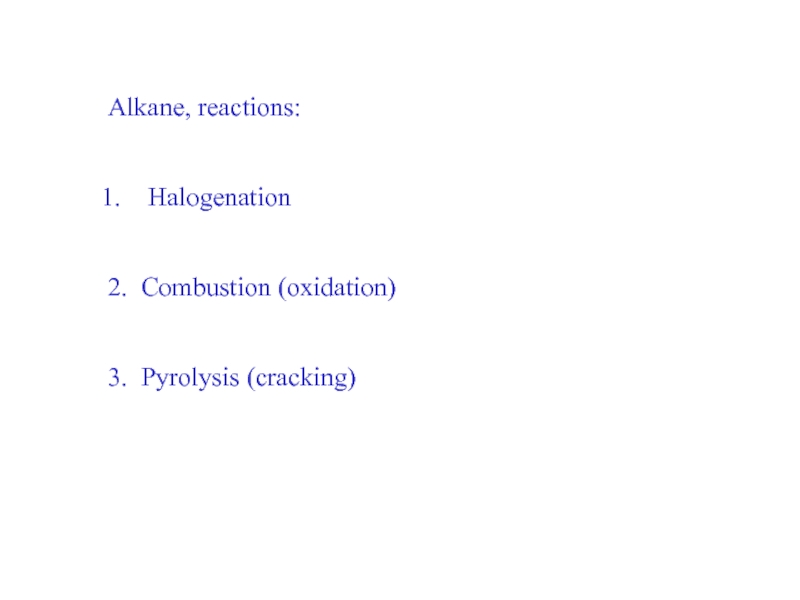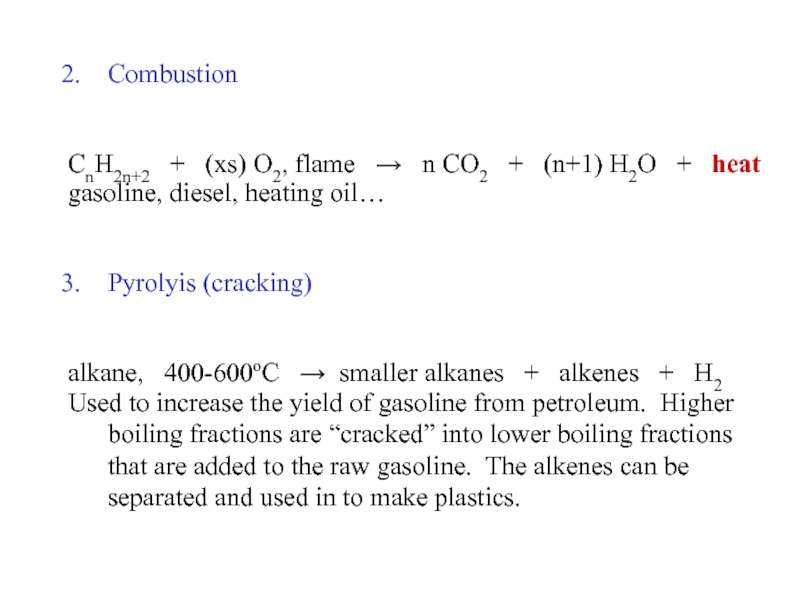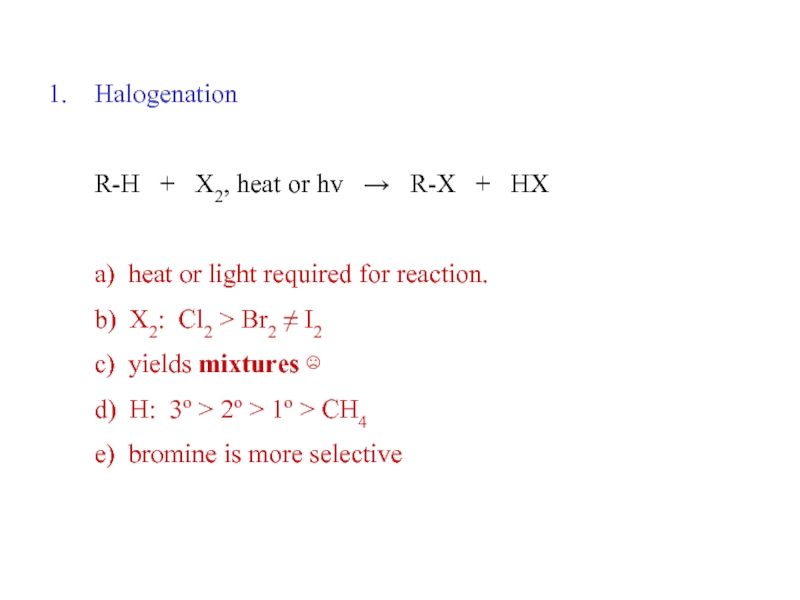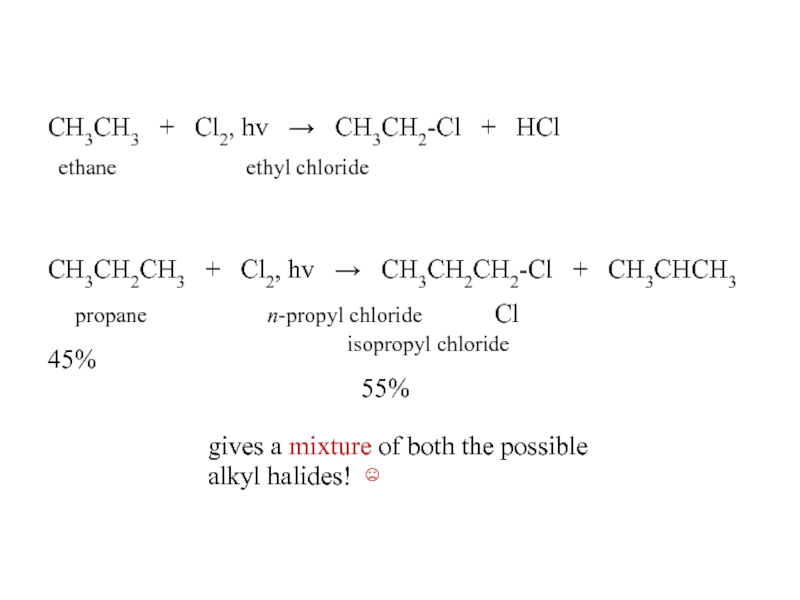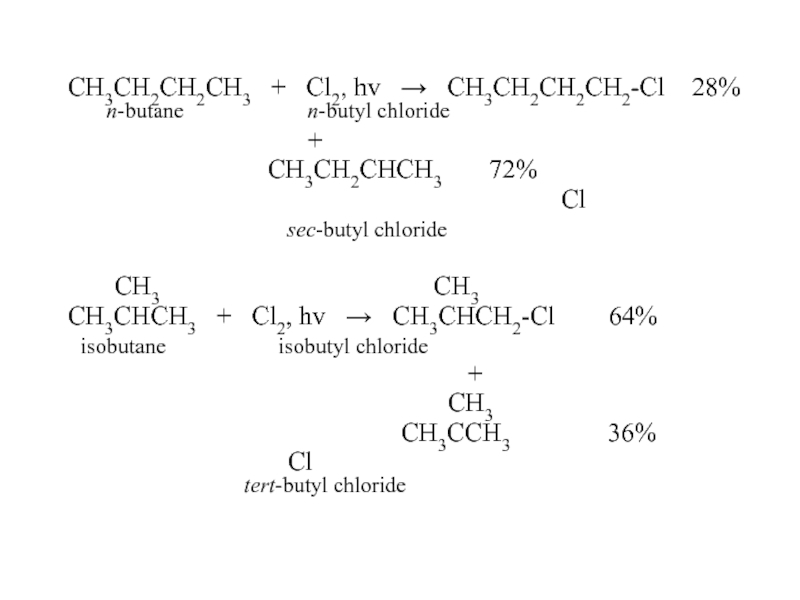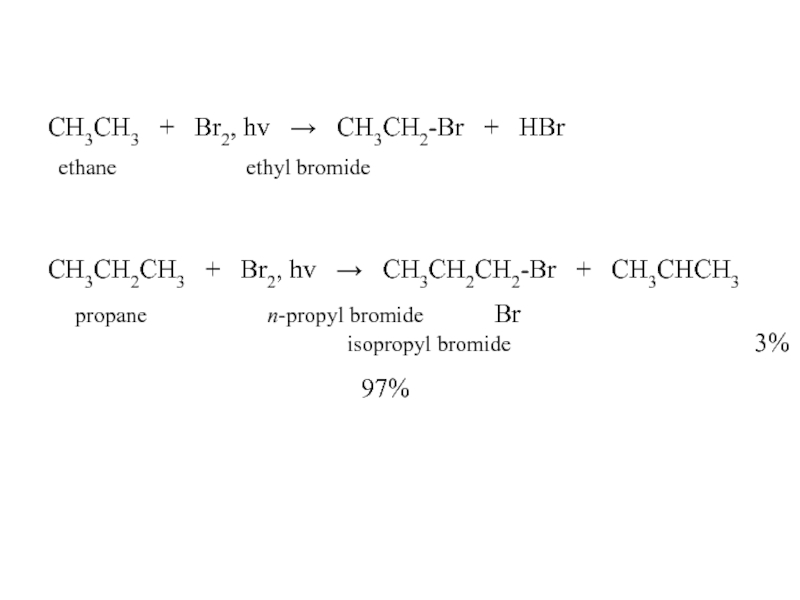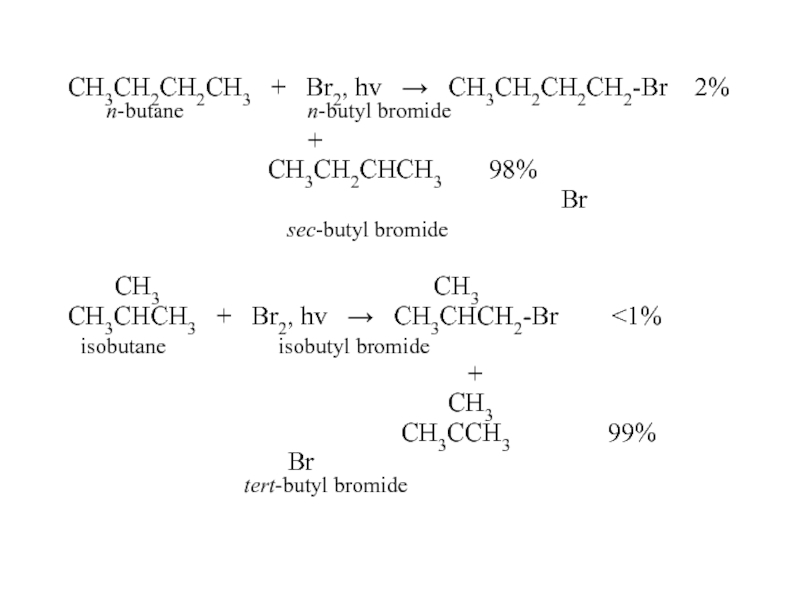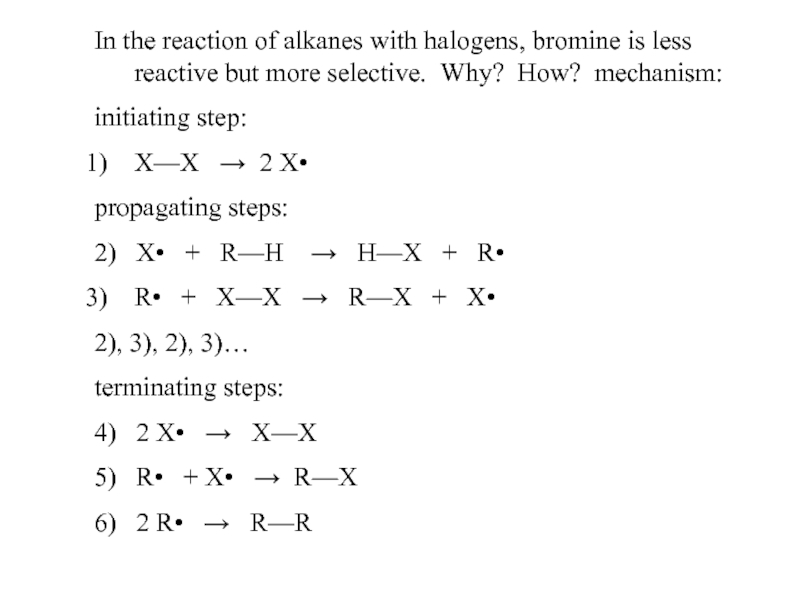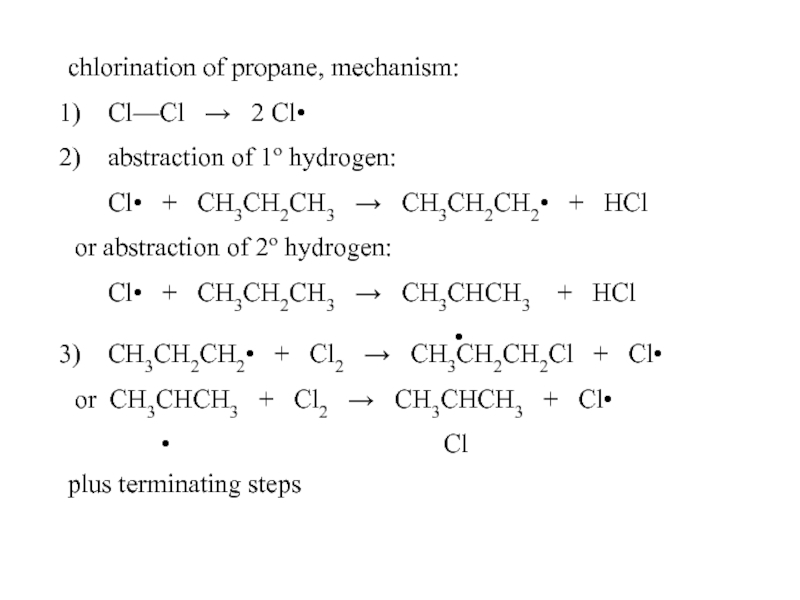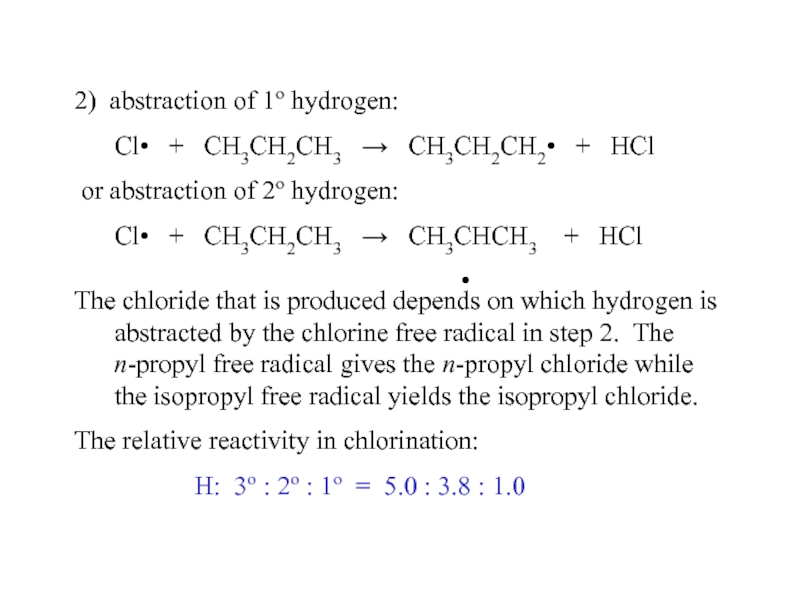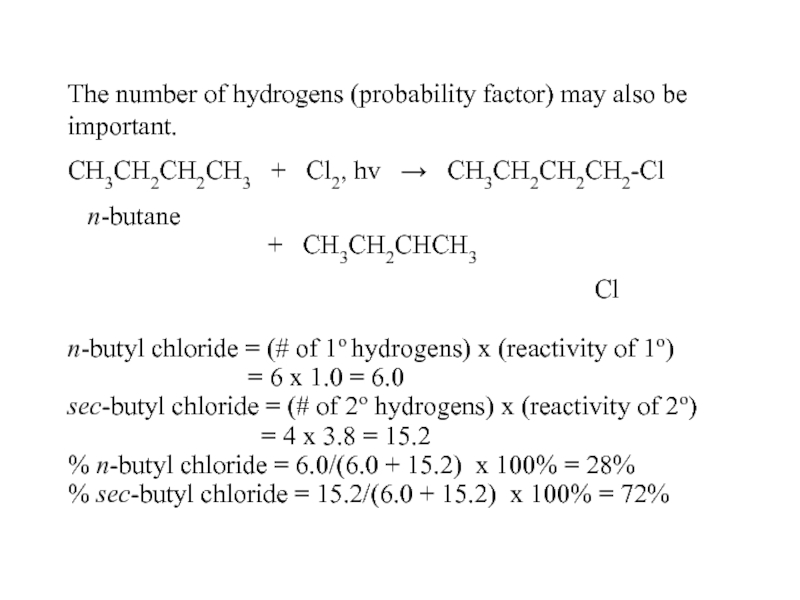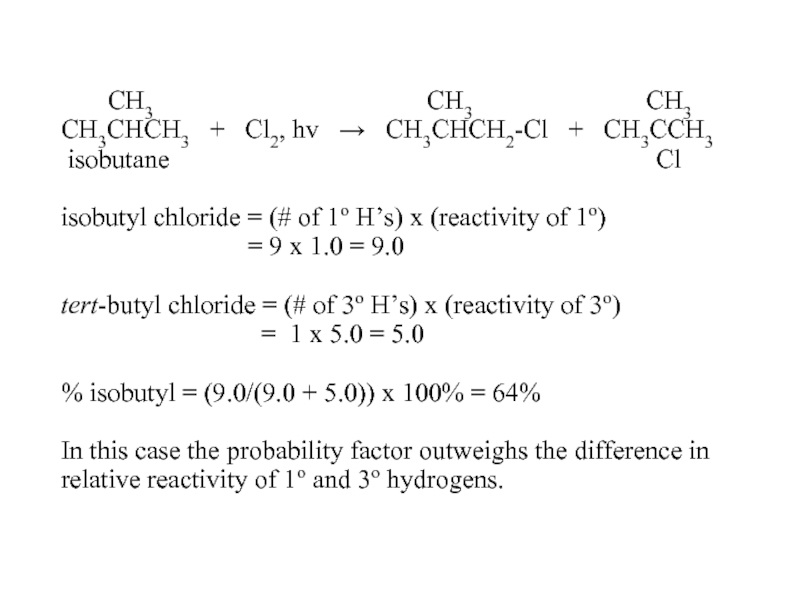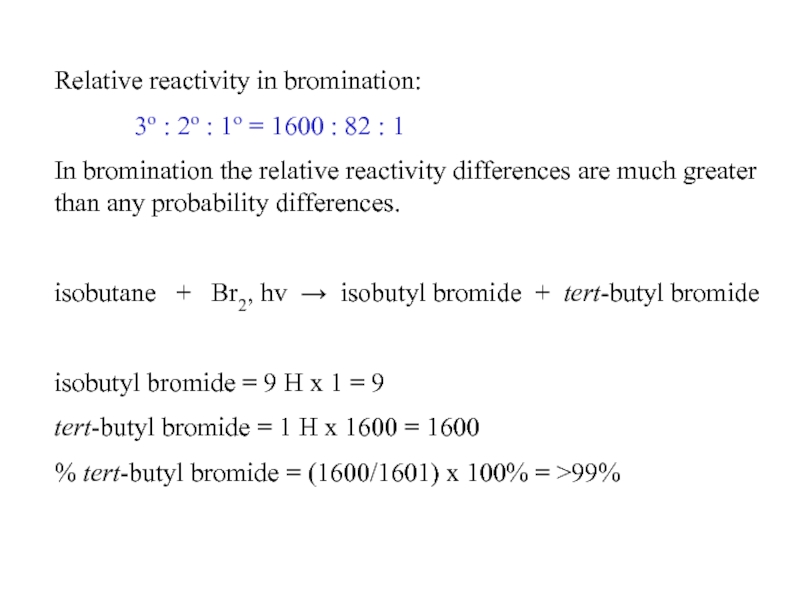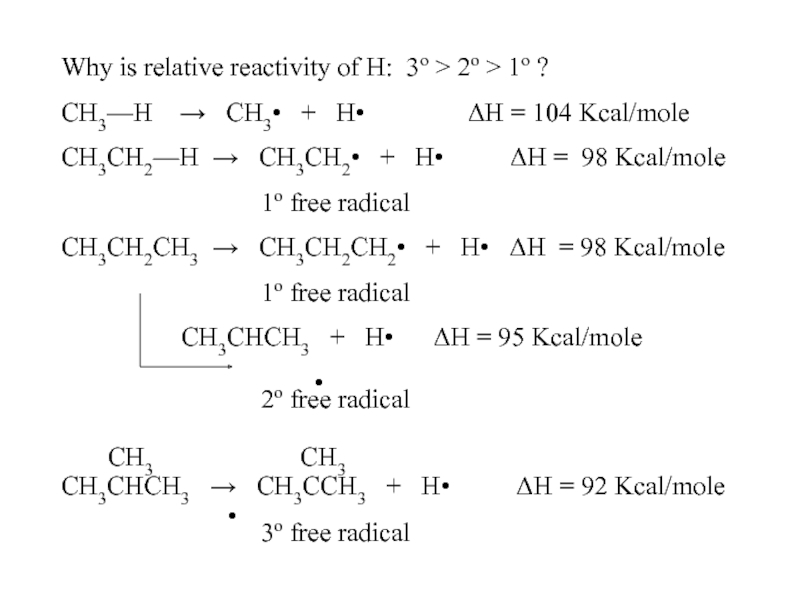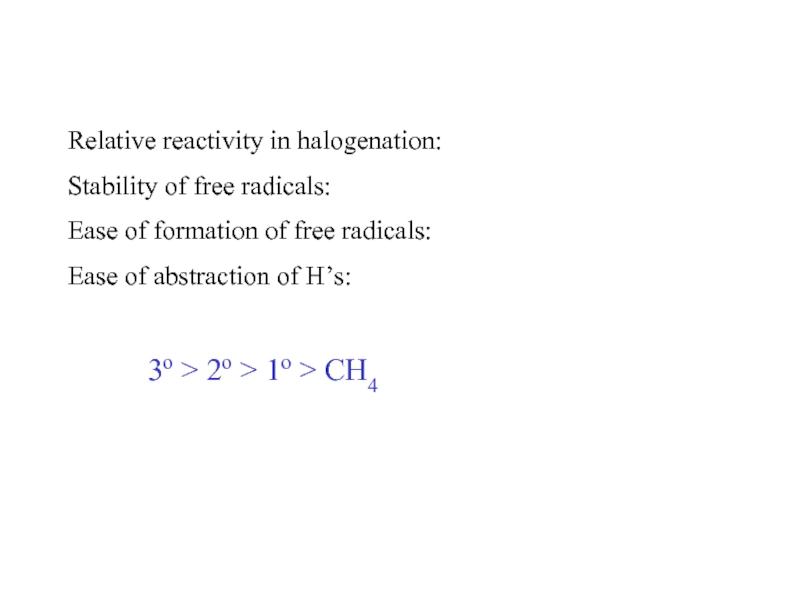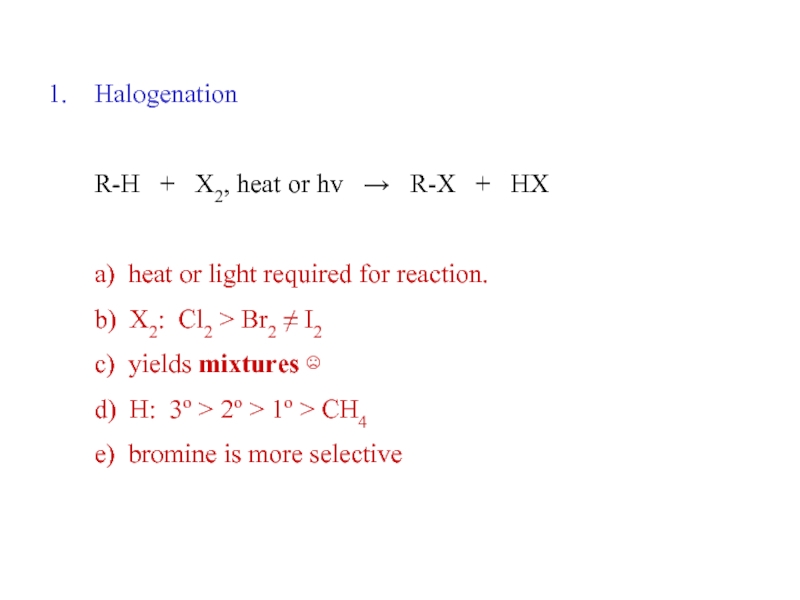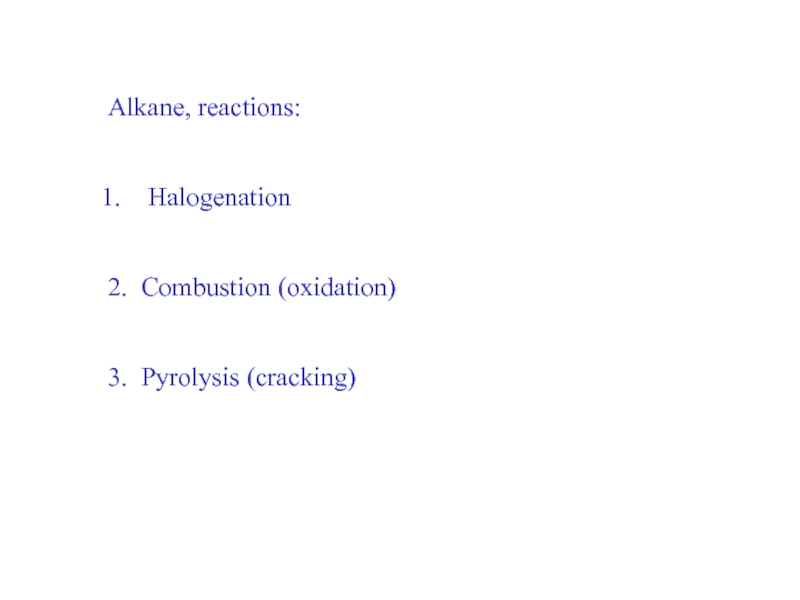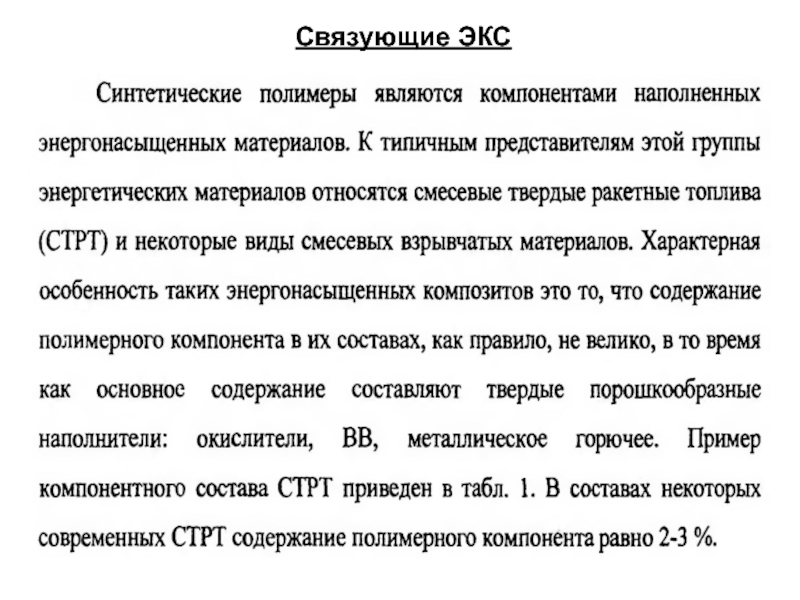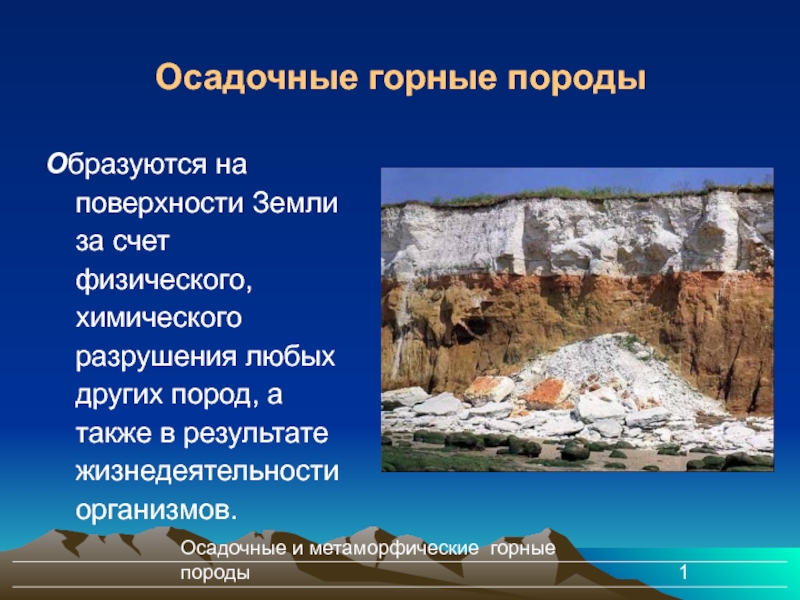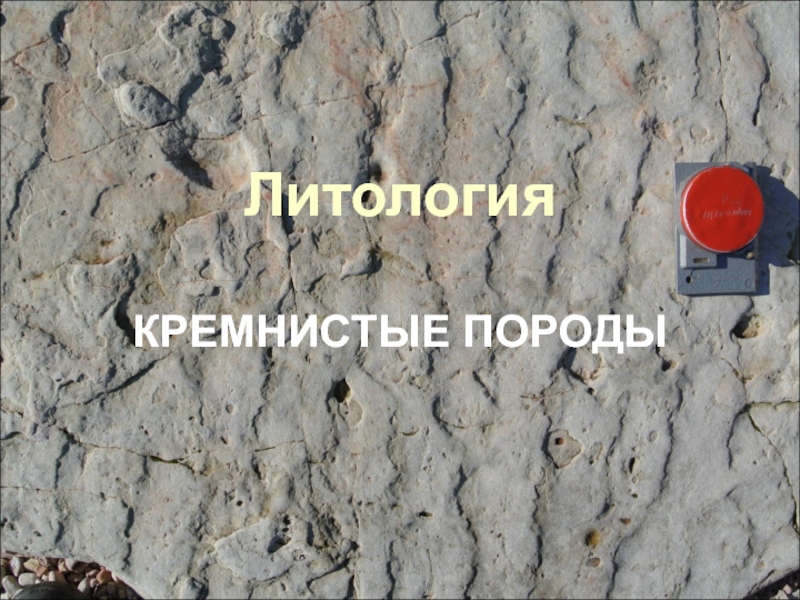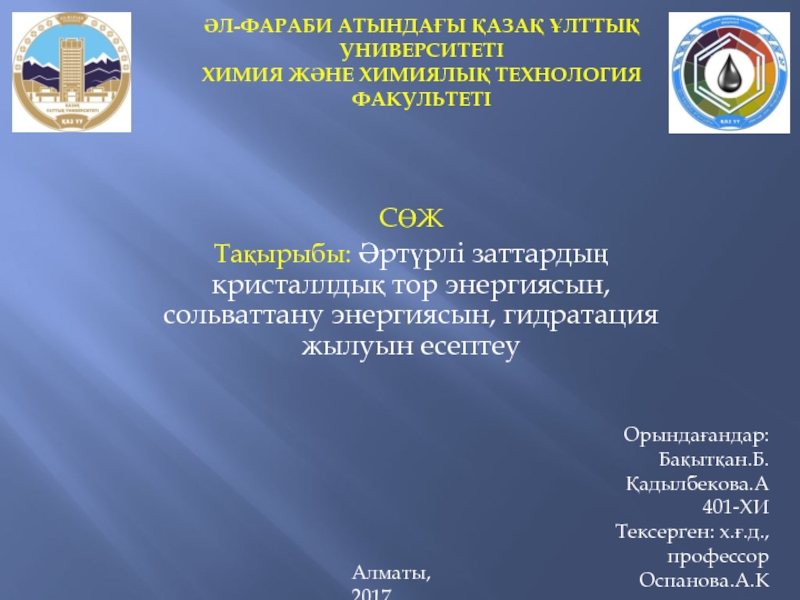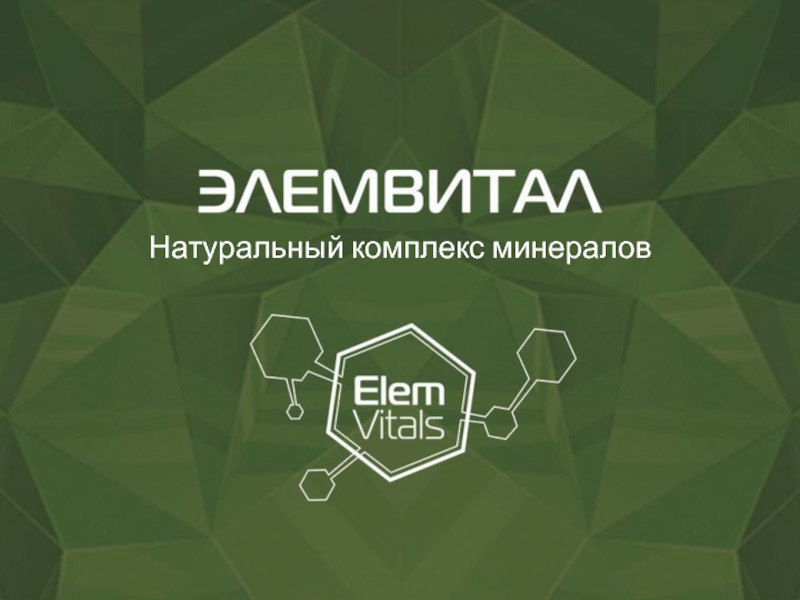- Главная
- Разное
- Дизайн
- Бизнес и предпринимательство
- Аналитика
- Образование
- Развлечения
- Красота и здоровье
- Финансы
- Государство
- Путешествия
- Спорт
- Недвижимость
- Армия
- Графика
- Культурология
- Еда и кулинария
- Лингвистика
- Английский язык
- Астрономия
- Алгебра
- Биология
- География
- Детские презентации
- Информатика
- История
- Литература
- Маркетинг
- Математика
- Медицина
- Менеджмент
- Музыка
- МХК
- Немецкий язык
- ОБЖ
- Обществознание
- Окружающий мир
- Педагогика
- Русский язык
- Технология
- Физика
- Философия
- Химия
- Шаблоны, картинки для презентаций
- Экология
- Экономика
- Юриспруденция
Alkanes. A “family” of hydrocarbons презентация
Содержание
- 1. Alkanes. A “family” of hydrocarbons
- 2. ALKANES (a “family” of hydrocarbons) CnH2n+2 CH4 C2H6
- 3. sp3, bond angles = 109.5o σ-bonds (sigma)
- 4. “staggered” “eclipsed” torsional strain: deviation from staggered. Newman projections:
- 5. The barrier to rotation about the carbon-carbon
- 9. Two isomers of butane C4H10: CH3CH2CH2CH3 n-butane
- 11. conformations about C2-C3 in n-butane:
- 13. Alkane name isomers CH4 methane 1 C2H6 ethane 1
- 14. hexanes C6H14 common
- 15. IUPAC nomenclature (Geneva, 1920) names of
- 16. CH3CH2CH2CH2- “n-butyl”
- 20. Web problems to help with naming
- 21. IUPAC rules for naming alkanes: parent chain
- 22. hexanes C6H14 IUPAC
- 23. CH3CH2 CH2CHCH2CHCH3
- 24. “classes of carbons” primary carbon (1o) –
- 25. classification of hydrogens, halides – hydrogens or
- 26. alkanes, physical properties non-polar or only weakly
- 27. alkane mp oC bp oC methane -183 -162 ethane -172 -89 propane -187 -42 n-butane -138 0
- 28. fossil fuels: natural gas petroleum coal petroleum
- 29. products from fractional distillation of petroleum: fraction b.
- 30. syntheses Industrial Laboratory large amounts
- 31. Alkanes, syntheses: (to be covered later)
- 32. Reduction of an alkyl halide
- 33. CH3
- 34. with an active metal and an acid
- 35. Corey-House synthesis R-X +
- 36. note: the previous equations are not balanced:
- 37. CH3
- 38. Alkanes, syntheses: (to be covered later)
- 39. ALKANES ALKYL HALIDES Mg H2O Sn,HCl Li CuI R’X
- 40. Reactions of alkanes: alkane +
- 41. Alkane, reactions: Halogenation 2. Combustion (oxidation) 3. Pyrolysis (cracking)
- 42. Combustion CnH2n+2 + (xs)
- 43. Halogenation R-H + X2,
- 44. CH3CH3 + Cl2, hv
- 45. CH3CH2CH2CH3 + Cl2, hv
- 46. CH3CH3 + Br2, hv
- 47. CH3CH2CH2CH3 + Br2, hv
- 48. In the reaction of alkanes with halogens,
- 49. chlorination of propane, mechanism: Cl—Cl →
- 50. 2) abstraction of 1o hydrogen:
- 51. The number of hydrogens (probability factor) may
- 52. CH3
- 53. Relative reactivity in bromination: 3o : 2o
- 54. Why is relative reactivity of H: 3o
- 55. Relative reactivity in halogenation: Stability of free
- 56. Halogenation R-H + X2,
- 57. Alkane, reactions: Halogenation 2. Combustion (oxidation) 3. Pyrolysis (cracking)
Слайд 2ALKANES
(a “family” of hydrocarbons)
CnH2n+2 CH4
C2H6
C3H8
C4H10
etc.
C2H6 ethane
H—C—C—H
H H
Слайд 3 sp3, bond angles = 109.5o
σ-bonds (sigma)
rotation about C--C (conformations)
representation:
“andiron” or “sawhorse”
Слайд 5The barrier to rotation about the carbon-carbon bond in ethane is
Слайд 9Two isomers of butane C4H10:
CH3CH2CH2CH3 n-butane
bp 0 oC
mp –138 oC
d
CH3
CH3CHCH3 isobutane
bp -12 oC
mp -159 oC
d 0.604 g/cc
Слайд 13Alkane name isomers
CH4 methane 1
C2H6 ethane 1
C3H8 propane 1
C4H10 butanes 2
C5H12 pentanes 3
C6H14 hexanes
C7H16 heptanes 9
C8H18 octanes 18
C9H20 nonanes 35
C10H22 decanes 75
…….
C20H42 eicosanes 366,319
each new common name requires a new prefix…
Слайд 14
hexanes C6H14 common names
CH3CH2CH2CH2CH2CH3 CH3CHCH2CH2CH3
n-hexane isohexane
CH3 CH3
CH3CH2CHCH2CH3 CH3CCH2CH3
????? CH3
neohexane
CH3
CH3CHCHCH3
CH3
????
Слайд 15IUPAC nomenclature (Geneva, 1920)
names of radicals (alkyl groups):
CH3- “methyl” CH3Cl
CH3OH methyl alcohol, etc.
CH3CH2- “ethyl”
CH3CH2CH2- “n-propyl” CH3CHCH3 “isopropyl”
|
Слайд 16CH3CH2CH2CH2- “n-butyl”
CH3CH2CHCH3 or CH3CH2CH- “sec-butyl”
|
CH3
CH3CHCH2- “isobutyl”
CH3
CH3CCH3 “tert-butyl”
|
Слайд 20
Web problems to help with naming and recognizing organic radicals:
Click here
or
http://proton.csudh.edu/structures/butyls/hwbutyls.html
Слайд 21IUPAC rules for naming alkanes:
parent chain = longest continuous carbon chain
branches on the parent chain are named as “alkyl” groups.
number the parent chain starting from the end that gives you the lower number for the first branch (principle of lower number).
assign “locants” to the alkyl branches.
if an alkyl group appears more than once use prefixes: di, tri, tetra, penta…; each alkyl group must have a locant!
the name is written as one word with the parent name last. The names and locants for the alkyl branches are put in alphabetic order (ignore all prefixes except iso) separating numbers from numbers with commas and letters from numbers with hyphens.
Слайд 22
hexanes C6H14 IUPAC names
CH3CH2CH2CH2CH2CH3 CH3CHCH2CH2CH3
(n-hexane) (isohexane)
n-hexane 2-methylpentane
CH3 CH3
CH3CH2CHCH2CH3 CH3CCH2CH3
(no common name) CH3
3-methylpentane (neohexane)
2,2-dimethylbutane
CH3
CH3CHCHCH3
CH3
(no common name)
2,3-dimethylbutane
Слайд 23CH3CH2
CH2CHCH2CHCH3
2,4-dimethylheptane
CH3 CH3
CH
CH3CH2CH2CHCH2 CH3
CH2CH2CCH3
CH3
6-isopropyl-2,2-dimethylnonane
Слайд 24“classes of carbons”
primary carbon (1o) – a carbon bonded to one
secondary carbon (2o) – a carbon bonded to two carbons
tertiary carbon (3o) – a carbon bonded to three carbons
quaternary carbon (4o) – a carbon bonded to four carbons
1o
4o
CH3 CH3
CH3CHCH2CH2CCH3 1o
CH3
3o 2o
Слайд 25classification of hydrogens, halides – hydrogens or halides are classified by
1o
CH3
CH3CHCH2CH2CH3
1o 3o 2o 2o 1o
CH3CH2CHCH3 sec-butyl bromide 2o bromide
Br
CH3
CH3CCH3 tert-butyl chloride 3o chloride
Cl
Слайд 26alkanes, physical properties
non-polar or only weakly polar, cannot hydrogen bond →
lower mp/bp; increase with size; decrease with branching
@ room temperature:
C1 – C4 are gases
C5 – C17 are liquids
> C17 are solids
alkanes are water insoluble
Слайд 27alkane mp oC bp oC
methane -183 -162
ethane -172 -89
propane -187 -42
n-butane -138 0
n-pentane -130 36
n-hexane -95 69
…
n-heptadecane 22 292
n-octadecane 28 308
branching lowers mp/bp
n-pentane -130 36
isopentane -160 28
Слайд 28fossil fuels:
natural gas
petroleum
coal
petroleum is a complex mixture of hydrocarbons
1. solvents
2. fuels
3.
separated into fractions by fractional distillation in an oil refinery
Слайд 29products from fractional distillation of petroleum:
fraction b. range carbons
natural gas below 20o C1 – C4
petroleum
ligroin 60 – 100o C6 – C7
raw gasoline 40 – 205o C5 – C10
kerosine 175 – 325o C12 – C18
gas oil above 275o C12 & up
lube oil non-volaltile liquids
asphalt non-volatile solids
coke solid carbon
Слайд 30syntheses
Industrial Laboratory
large amounts (tons) small amounts (grams)
lowest
mixtures often okay pure substances
dedicated apparatus flexible apparatus
on exams, homework: laboratory syntheses!
Слайд 31Alkanes, syntheses:
(to be covered later)
Reduction of an alkyl halide
a) hydrolysis of
b) with an active metal and an acid
Corey-House synthesis
(coupling of an alkyl halide with lithium dialkylcopper)
Слайд 32Reduction of an alkyl halide
a) hydrolysis of a
i) R—X + Mg → RMgX (Grignard reagent)
ii) RMgX + H2O → RH + Mg(OH)X
SB SA WA WB
CH3CH2CH2-Br + Mg → CH3CH2CH2-MgBr
n-propyl bromide n-propyl magnesium bromide
CH3CH2CH2-MgBr + H2O → CH3CH2CH3 + Mg(OH)Br
propane
Слайд 33
CH3
CH3CH-Br + Mg → CH3CH-MgBr
isopropyl bromide isopropyl magnesium bromide
CH3
CH3CH-MgBr + H2O → CH3CH2CH3
propane
CH3CH2CH2-MgBr + D2O → CH3CH2CH2D
heavy water
CH3 CH3
CH3CH-MgBr + D2O → CH3CHD
Слайд 34with an active metal and an acid
R—X + metal/acid
active metals = Sn, Zn, Fe, etc.
acid = HCl, etc. (H+)
CH3CH2CHCH3 + Sn/HCl → CH3CH2CH2CH3 + SnCl2
Cl
sec-butyl chloride n-butane
CH3 CH3
CH3CCH3 + Zn/H+ → CH3CHCH3 + ZnBr2
Br
tert-butyl bromide isobutane
Слайд 35Corey-House synthesis
R-X + Li → R-Li
R2CuLi + R´-X → R—R´ (alkane)
(R´-X should be 1o or methyl)
This synthesis is important because it affords a synthesis of a larger alkane from two smaller alkyl halides.
Слайд 36note: the previous equations are not balanced:
R-X + 2
2 R-Li + CuI → R2CuLi + LiX
R
R2CuLi = R-Cu-, Li+
R2CuLi + R´X → R-R´ + RCu + LiX
Слайд 37 CH3 CH3
CH3CH-Br + Li → CH3CH-Li + CuI → (CH3CH)2-CuLi
isopropyl bromide
CH3 CH3
(CH3CH)2-CuLi + CH3CH2CH2-Br → CH3CH-CH2CH2CH3
2-methylpentane
(isohexane)
Note: the R´X should be a 1o or methyl halide for the best yields of the final product.
Слайд 38Alkanes, syntheses:
(to be covered later)
Reduction of an alkyl halide
a) hydrolysis of
b) with an active metal and an acid
Corey-House synthesis
(coupling of an alkyl halide with lithium dialkylcopper)
Слайд 40Reactions of alkanes:
alkane + H2SO4 →
alkane + NaOH → NR
alkane + Na → NR
alkane + KMnO4 → NR
alkane + H2,Ni → NR
alkane + Br2 → NR
alkane + H2O → NR
(Alkanes are typically non-reactive. They don’t react with acids, bases, active metals, oxidizing agents, reducing agents, halogens, etc.)
Слайд 42Combustion
CnH2n+2 + (xs) O2, flame → n
gasoline, diesel, heating oil…
Pyrolyis (cracking)
alkane, 400-600oC → smaller alkanes + alkenes + H2
Used to increase the yield of gasoline from petroleum. Higher boiling fractions are “cracked” into lower boiling fractions that are added to the raw gasoline. The alkenes can be separated and used in to make plastics.
Слайд 43Halogenation
R-H + X2, heat or hv →
a) heat or light required for reaction.
b) X2: Cl2 > Br2 ≠ I2
c) yields mixtures ☹
d) H: 3o > 2o > 1o > CH4
e) bromine is more selective
Слайд 44CH3CH3 + Cl2, hv → CH3CH2-Cl
ethane ethyl chloride
CH3CH2CH3 + Cl2, hv → CH3CH2CH2-Cl + CH3CHCH3
propane n-propyl chloride Cl
isopropyl chloride 45%
55%
gives a mixture of both the possible
alkyl halides! ☹
Слайд 45CH3CH2CH2CH3 + Cl2, hv → CH3CH2CH2CH2-Cl
n-butane n-butyl chloride
+
CH3CH2CHCH3 72%
Cl
sec-butyl chloride
CH3 CH3
CH3CHCH3 + Cl2, hv → CH3CHCH2-Cl 64%
isobutane isobutyl chloride
+
CH3
CH3CCH3 36%
Cl
tert-butyl chloride
Слайд 46CH3CH3 + Br2, hv → CH3CH2-Br
ethane ethyl bromide
CH3CH2CH3 + Br2, hv → CH3CH2CH2-Br + CH3CHCH3
propane n-propyl bromide Br
isopropyl bromide 3%
97%
Слайд 47CH3CH2CH2CH3 + Br2, hv → CH3CH2CH2CH2-Br
n-butane n-butyl bromide
+
CH3CH2CHCH3 98%
Br
sec-butyl bromide
CH3 CH3
CH3CHCH3 + Br2, hv → CH3CHCH2-Br <1%
isobutane isobutyl bromide
+
CH3
CH3CCH3 99%
Br
tert-butyl bromide
Слайд 48In the reaction of alkanes with halogens, bromine is less reactive
initiating step:
X—X → 2 X•
propagating steps:
2) X• + R—H → H—X + R•
R• + X—X → R—X + X•
2), 3), 2), 3)…
terminating steps:
4) 2 X• → X—X
5) R• + X• → R—X
6) 2 R• → R—R
Слайд 49chlorination of propane, mechanism:
Cl—Cl → 2 Cl•
abstraction of 1o
Cl• + CH3CH2CH3 → CH3CH2CH2• + HCl
or abstraction of 2o hydrogen:
Cl• + CH3CH2CH3 → CH3CHCH3 + HCl
•
CH3CH2CH2• + Cl2 → CH3CH2CH2Cl + Cl•
or CH3CHCH3 + Cl2 → CH3CHCH3 + Cl•
• Cl
plus terminating steps
Слайд 502) abstraction of 1o hydrogen:
Cl• +
or abstraction of 2o hydrogen:
Cl• + CH3CH2CH3 → CH3CHCH3 + HCl
•
The chloride that is produced depends on which hydrogen is abstracted by the chlorine free radical in step 2. The n-propyl free radical gives the n-propyl chloride while the isopropyl free radical yields the isopropyl chloride.
The relative reactivity in chlorination:
H: 3o : 2o : 1o = 5.0 : 3.8 : 1.0
Слайд 51The number of hydrogens (probability factor) may also be important.
CH3CH2CH2CH3
n-butane
+ CH3CH2CHCH3
Cl
n-butyl chloride = (# of 1o hydrogens) x (reactivity of 1o)
= 6 x 1.0 = 6.0
sec-butyl chloride = (# of 2o hydrogens) x (reactivity of 2o)
= 4 x 3.8 = 15.2
% n-butyl chloride = 6.0/(6.0 + 15.2) x 100% = 28%
% sec-butyl chloride = 15.2/(6.0 + 15.2) x 100% = 72%
Слайд 52 CH3
CH3CHCH3 + Cl2, hv → CH3CHCH2-Cl + CH3CCH3
isobutane Cl
isobutyl chloride = (# of 1o H’s) x (reactivity of 1o)
= 9 x 1.0 = 9.0
tert-butyl chloride = (# of 3o H’s) x (reactivity of 3o)
= 1 x 5.0 = 5.0
% isobutyl = (9.0/(9.0 + 5.0)) x 100% = 64%
In this case the probability factor outweighs the difference in
relative reactivity of 1o and 3o hydrogens.
Слайд 53Relative reactivity in bromination:
3o : 2o : 1o = 1600 :
In bromination the relative reactivity differences are much greater than any probability differences.
isobutane + Br2, hv → isobutyl bromide + tert-butyl bromide
isobutyl bromide = 9 H x 1 = 9
tert-butyl bromide = 1 H x 1600 = 1600
% tert-butyl bromide = (1600/1601) x 100% = >99%
Слайд 54Why is relative reactivity of H: 3o > 2o > 1o
CH3—H → CH3• + H• ΔH = 104 Kcal/mole
CH3CH2—H → CH3CH2• + H• ΔH = 98 Kcal/mole
1o free radical
CH3CH2CH3 → CH3CH2CH2• + H• ΔH = 98 Kcal/mole
1o free radical
CH3CHCH3 + H• ΔH = 95 Kcal/mole
•
2o free radical
CH3 CH3
CH3CHCH3 → CH3CCH3 + H• ΔH = 92 Kcal/mole
•
3o free radical
Слайд 55Relative reactivity in halogenation:
Stability of free radicals:
Ease of formation of free
Ease of abstraction of H’s:
3o > 2o > 1o > CH4
Слайд 56Halogenation
R-H + X2, heat or hv →
a) heat or light required for reaction.
b) X2: Cl2 > Br2 ≠ I2
c) yields mixtures ☹
d) H: 3o > 2o > 1o > CH4
e) bromine is more selective

